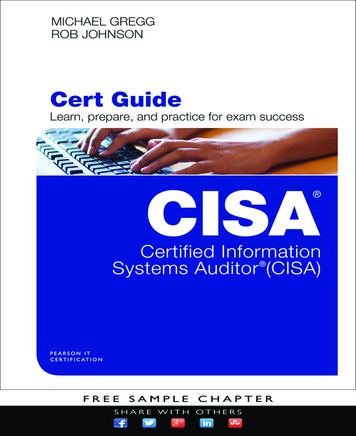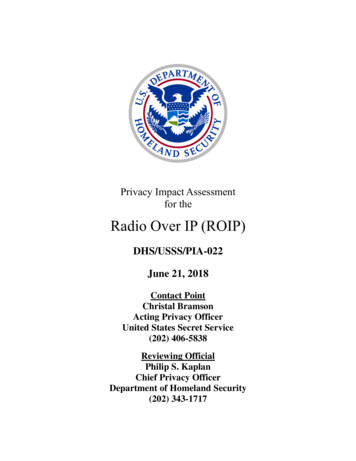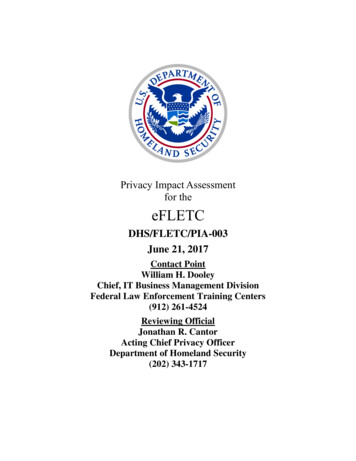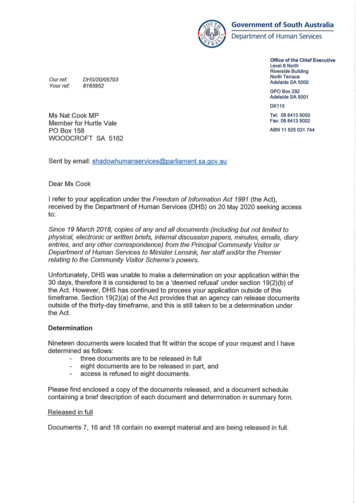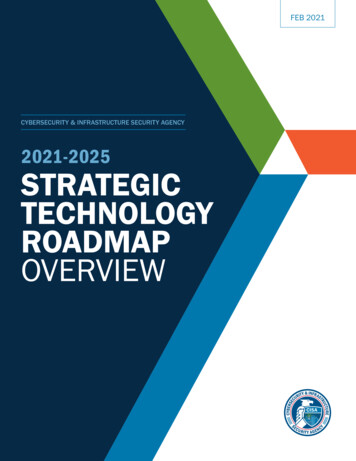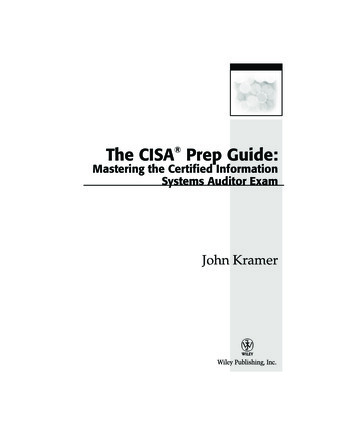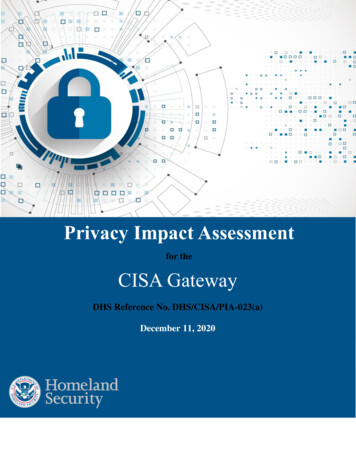
Transcription
3Privacy Impact Assessmentfor theCISA GatewayDHS Reference No. DHS/CISA/PIA-023(a)December 11, 2020
Privacy Impact AssessmentDHS/CISA/PIA-023(a) CISA GatewayPage 1AbstractThe U.S. Department of Homeland Security (DHS), Cybersecurity and InfrastructureSecurity Agency (CISA), Infrastructure Security Division (ISD) maintains the CISA Gateway, asystem formerly known as Infrastructure Protection (IP) Gateway, a web-based portal that supportsthe collection, analysis, and dissemination of critical infrastructure information. CISA publishedthe original IP Gateway Privacy Impact Assessment (PIA) in 2015 and provided a subsequentupdate in 2018. CISA is updating and reissuing DHS/CISA/PIA-023 to document a new sign-onmechanism, an interface with a two-factor authentication system, migration to a cloudenvironment, a system name change from IP Gateway to CISA Gateway, and to reflect the agencyname change from the National Protection and Programs Directorate (NPPD) to CISA. This PIAreflects these updates and fully re-assesses privacy risks and mitigations for the system.OverviewCISA ISD leads the coordinated national effort to protect critical infrastructure1 from allhazards by managing risk and enhancing resilience through collaboration with federal, state, local,tribal, territorial, and private sector partners in the critical infrastructure community. In support ofthis mission, ISD developed the CISA Gateway to encompass numerous applications2 and toolsmaintained by ISD and other components within CISA to reflect the reorganized nature of CISAas a new operational component of DHS. The primary purpose of the CISA Gateway is to providea framework for enhanced sharing of infrastructure information. The CISA Gateway is a webbased portal that supports the collection, analysis, and dissemination of infrastructure information.Applications on the CISA Gateway will be accessed by logging in to the main CISAGateway user interface using two-factor authentication (2FA). Access to the CISA Gateway isrestricted to only federal, state, local, tribal, and territorial critical infrastructure mission partnersthat possess homeland security responsibilities, have a valid “need to know,”3 and have completedProtected Critical Infrastructure Information (PCII)4 authorized user training.1Section 1016(e) of the USA PATRIOT Act of 2001 (42 U.S.C. § 5195c(e)) defines critical infrastructure as namelysystems and assets, whether physical or virtual, so vital to the United States that the incapacity or destruction of suchsystems and assets would have a debilitating impact on security, national economic security, national public healthor safety, or any combination of those matters.2“Application” refers to a single capability under the three capability groups (i.e., Data Collection and Web-BasedDashboards, Information Sharing and Training Tools, and Administrative, Management, and Reporting Capabilities)described in the Overview section. The term “application” does not refer to a separate system or sub-system.3A federal government user’s “need to know” is determined by whether or not access to the information isnecessary in order to perform his or her official duties. For state and local government users, their particular statesdefine what is considered to be a valid “need to know” for access to the CISA Gateway.4PCII is a program that protects infrastructure information voluntarily shared with DHS to be used for homelandsecurity purposes. As authorized by the Critical Infrastructure Information Act of 2002, PCII in the Government’shands is protected from disclosure. See Critical Infrastructure Information Act of 2002, available ions/CII-Act 508.pdf. Also see U.S. DEPARTMENT OF
Privacy Impact AssessmentDHS/CISA/PIA-023(a) CISA GatewayPage 2Individuals may request access to the CISA Gateway by completing the CISA GatewayAccount Request form via the CISA Gateway registration website at https://gateway.cisa.gov. TheCISA Gateway Account Request Form requests various data elements, which differ based on thetype of applicant (i.e., federal employee, federal contractor, state government employee, stategovernment contractor, local government employee, or local government contractor) that isrequesting access to the CISA Gateway.CISA Gateway Capability GroupsThe CISA Gateway provides users with access to a number of applications supportingactivities such as data collection and management, operational scheduling, report management,and analysis for comprehensive risk assessment, management/mitigation, and contingencyplanning. For the sake of clarity, the applications that reside on the CISA Gateway can be groupedinto three main capabilities: Data Collection and Web-Based Dashboards; Information Sharing and Training Tools; and Administrative, Management, and Reporting Capabilities.Capability Group 1: Data Collection and Web-Based Dashboards The purpose of the data collection and web-based dashboards is to collect anddisplay data for the Protective Security Advisors (PSA),5 Sector Specific Agencies(SSA),6 and the State, Local, Tribal, and Territorial (SLTT) communities. Thesecapabilities allow for analysis of performance and review of vulnerabilities ofCritical Infrastructure (CI). The focus is on physical security, cybersecurity,security force, security management, information sharing, protective measures, andinternal and external dependencies. The web-based dashboards are used to convey,track, manage, and graphically display information collected by the PSAs orthrough incident reporting. Geospatial information is collected through dataHOMELAND SECURITY, CYBERSECUIRTY AND INFRASTRUCTURE SECUIRTY AGENCY, PRIVACYIMPACT ASSESMENT FOR THE PROTECTED CRITICAL INFRASTRUCTURE INFORMATIONPROGRAM, DHS/NPPD/PIA-034 (2019), available at: https://www.dhs.gov/privacy-documents-cisa.5PSAs facilitate field activities in coordination with other DHS offices. The PSA Program maintains a robustoperational field capability by conducting assessments of nationally significant critical infrastructure throughEnhanced Critical Infrastructure Protection (ECIP) security surveys; site assistance visits and incident response; andproviding access to infrastructure security and resilience resources, training, and information.6SSAs are federal departments or agencies designated under Presidential Policy Directive-21 (PPD-21) to beresponsible for providing institutional knowledge and specialized expertise as well as leading, facilitating, orsupporting the security and resilience programs and associated activities of its designated critical infrastructuresector in the all-hazards environment. See PPD-21, Critical Infrastructure Security and Resilience (Feb. 12, 2013)available at calinfrastructure-security-and-resil.
Privacy Impact AssessmentDHS/CISA/PIA-023(a) CISA GatewayPage 3collection functions and updated to DHS geospatially-enabled data. This data isthen used to display the reports and maps of CI facilities in a query.Capability Group 2: Information Sharing and Training Tools The information sharing and training functionality includes dynamic sharing of dataand information sources across the critical infrastructure community, includingfacility owners and operators, and SLTT community partners. The informationsharing tools enable stakeholders to easily access, search, retrieve, visualize,analyze, and export infrastructure data and protective measures. Data purviewrestrictions and access controls are managed within the individual applicationsbased on a user’s need to know. The movement of information and data throughthe communication channels across the organization (from field personnel toHeadquarters), along with the short and long-term storage capabilities, allows thearchival, retrieval, and handling of data at will. The ability to provide simpleknowledge management provides relevant material for designing training contentfor both employees as well as stakeholders.Capability Group 3: Administrative, Management, and Reporting Capabilities The administrative, management, and reporting functionality is used to schedule,track, coordinate, and maintain activities in the field. This set of capabilities allowsboth field personnel and CISA leadership at Headquarters to provide performancemanagement metrics and quickly assess impacts of missions in the field. Inaddition, the CISA Gateway provides the ability to connect personnel atHeadquarters with personnel in the field who are performing the critical functionsto protect our Critical Infrastructure.CISA Gateway applications7 may collect business contact information from users and other Pointsof Contact (POC). POCs may include, but are not limited to, private sector partners or stakeholdersassociated with specific infrastructure assets. CISA may use this information to communicate withfacilities in support of its infrastructure protection mission. For example, during an event orincident, such as an attack or natural disaster, CISA may need to contact facility owners oroperators to convey information to help protect their infrastructure. The information collected fromPOCs is limited to business contact information, such as full name, email address, office phonenumber, cell phone number, and business address.This PIA serves as an update and a replacement for DHS/NPPD/PIA-023 PIA“Infrastructure Protection (IP) Gateway,” dated September 11, 2018. Since the 2018 PIA, the7See Appendix A for the current list of all CISA Gateway applications divided into separate CISA GatewayCapability Groups.
Privacy Impact AssessmentDHS/CISA/PIA-023(a) CISA GatewayPage 4renamed CISA Gateway has been updated to incorporate a new sign-on mechanism, to interfacewith a two-factor authentication system, and has been migrated to a cloud environment.Initially, CISA Gateway will continue to use Homeland Security Information Network(HSIN)8 for system access during its implementation phase as described in the 2018 update ofDHS/NPPD/PIA-023 for IP Gateway. Once CISA Gateway receives its Authority to Operate(ATO), it will migrate to DHS’ implementation of Application Authentication (AppAuth) forSingle Sign On services for authentication, enabling DHS users across the Department to log onto enterprise applications using their normal component login credentials. The system will abideby and inherit the privacy controls that are currently in place for the AppAuth system asdocumented in its respective PIA.9Users outside of DHS will no longer use HSIN for access. Non-DHS users will log onusing 2FA with a username and password which is authenticated via a five (5) or six (6) digitverification number sent via text or email to the contact point that was placed on file when the useroriginally registered his or her account.The system is also adding an application programming interface (API) Connection10 out tothe CISA Cybersecurity Division’s Tardis application. Tardis is an Event and Incident ticketingplatform which is currently a part of the Incident Management System (IMS) of the NationalCybersecurity Protection System,11 which, like CISA Gateway, also requires PCII training foraccess. The sharing of PCII training records will take place through a Memorandum ofUnderstanding (MOU) between the CISA Gateway System Owner and the Tardis System Ownerin order to allow Tardis users to pull their PCII Training statistics from the CISA Gateway toensure that the Tardis users have the requisite up-to-date PCII training record to access the Tardisapplication.8See U.S. DEPARTMENT OF HOMELAND SECURITY, PRIVACY IMPACT ASSESSMENT FOR HSINRELEASE 3 USER ACCOUNTS, DHS/ALL/PIA-061-1 (2012 and subsequent updates), available -wide-programs.9See U.S. DEPARTMENT OF HOMELAND SECURITY, PRIVACY IMPACT ASSESSMENT FORAPPLICATION AUTHENTICATION SYSTEM, DHS/ALL/PIA-060 (2018), available -wide-programs.10An API is a computing interface which defines interactions between multiple software intermediaries. CISAGateway will be an API connection to send an encrypted PCII training status in a “yes/no” type response over to theTardis application.11See U.S. DEPARTMENT OF HOMELAND SECURITY, CYBERSECURITY AND INFRASTRUCTURESECURITY AGENCY, PRIVACY IMPACT ASSESSMENT FOR THE NATIONAL CYBERSECURITYPROTECTION SYSTEM (NCPS), DHS/CISA/PIA-026 (2012), available at https://www.dhs.gov/privacydocuments-cisa.
Privacy Impact AssessmentDHS/CISA/PIA-023(a) CISA GatewayPage 5Section 1.0 Authorities and Other Requirements1.1What specific legal authorities and/or agreements permit anddefine the collection of information by the project in question?CISA Gateway is primarily used to collect non-privacy sensitive infrastructure informationas authorized by Section 2202 of the Cybersecurity and Infrastructure Security Agency Act of2018.12 Furthermore, CISA’s PCII program, authorized by the Critical Infrastructure InformationAct of 2002,13 controls the protection of the majority of the critical infrastructure informationcollected and maintained within the CISA Gateway.Presidential Policy Directive-21 (PPD-21) Critical Infrastructure Security and Resilience,issued in 2013, specifically directs DHS to:1) In coordination with SSAs and other federal departments and agencies, provide analysis,expertise, and other technical assistance to critical infrastructure owners and operators andfacilitate access to and exchange of information and intelligence necessary to strengthen thesecurity and resilience of critical infrastructure; and2) Conduct comprehensive assessments of the vulnerabilities of the nation’s criticalinfrastructure in coordination with SSAs and in collaboration with SLTT entities and criticalinfrastructure owners and operators.In support of PPD-21 and the CISA Act of 2018, CISA/ISD employs the CISA Gateway,which provides federal, state, and local government critical infrastructure mission partners withvarious data collection, analysis, and response tools in order to enhance critical infrastructureprotection.1.2What Privacy Act System of Records Notice(s) (SORN(s)) applyto the information?CISA collects PII from individuals for the purpose of granting access to the IP Gateway.This collection is covered by the DHS system of records notice titled, DHS/ALL-004 GeneralInformation Technology Access Account Records System (GITAARS).14 CISA also collects PIIto provide customer support to users through the CISA Gateway Help Desk. This collection iscovered under DHS/ALL-002 Department of Homeland Security (DHS) Mailing and Other ListsSystem.1512Pub. L. No. 115-278, 132 Stat. 4168 (2018) (codified at 6 U.S.C. § 652).Pub. L. No. 107-296, 116 Stat. 2150 (Nov. 25, 2002) (codified as amended at 6 U.S.C. § 671 et seq.).14See DHS/ALL-004 General Information Technology Access Account Records System (GITAARS), 77 Fed. Reg.70792, (Nov. 27, 2012), available at 12-28675.htm.15See DHS/ALL-002 Department of Homeland Security (DHS) Mailing and Other Lists System, 73 Fed. Reg.71659 (Nov. 25, 2008), available at -28053.htm.13
Privacy Impact AssessmentDHS/CISA/PIA-023(a) CISA GatewayPage 6In addition to the collections described above, the CISA Gateway may also maintainlimited business contact information on critical infrastructure POCs. This information, however,is not filed or retrieved by the individual’s PII and therefore is not covered by the Privacy Act.POC information is generally filed and retrieved by the name of a facility or other asset with whichthe individual is associated.1.3Has a system security plan been completed for the informationsystem(s) supporting the project?A system security plan is currently being drafted for the CISA Gateway and as ofNovember 2020, the date as to when an Authority to Operate (ATO) will be issued is stillundetermined as security controls brought up during system assessment are being remediated priorto implementation.1.4Does a records retention schedule approved by the NationalArchives and Records Administration (NARA) exist?User registration records are maintained in accordance with NARA’s General RetentionSchedule 3.2 – Information Systems Security Records, and records created through the CISAGateway Help Desk (IT Customer Service Files) are maintained in accordance with NARA’sGeneral Retention Schedule 24 – Information Technology Operations and Management Records.Additionally, NARA Job No. N1-563-08-36 covers the PCII submitted and maintainedthrough the CISA Gateway, and NARA Job No. N1-563-04-09 covers the critical infrastructuresubmissions that do not meet the requirements for PCII.1.5If the information is covered by the Paperwork Reduction Act(PRA), provide the OMB Control number and the agency numberfor the collection. If there are multiple forms, include a list in anappendix.In its previous iteration as IP Gateway, the system went through the PRA approval process.The CISA Gateway’s PRA package includes both the CISA Gateway Account Request Form (usedfor CISA Gateway user registration) and the voluntary CISA Gateway Customer SatisfactionSurvey. The PRA package received an OMB Control number of 1670-0009. This package wasapproved to include the necessary changes to the system which would evolve to be CISA Gateway,and the form used for user registration continues to be valid for CISA Gateway moving forward.
Privacy Impact AssessmentDHS/CISA/PIA-023(a) CISA GatewayPage 7Section 2.0 Characterization of the Information2.1Identify the information the project collects, uses, disseminates, ormaintains.In order to register for access to the CISA Gateway, individuals are required to providecertain information via the online CISA Gateway Account Request Form. This form requestsvarious data elements, which differ based on the type of applicant (i.e., federal employee, federalcontractor, state government employee, state government contractor, local government employee,or local government contractor) requesting access to the CISA Gateway. The information collectedby the CISA Gateway Account Request Form is outlined below.All applicants must provide the following information: Name; U.S. citizen (yes/no); Employee type (federal employee, federal contractor, state government employee,state government contractor, local government employee, or local governmentcontractor); Role requested (e.g., Assessor/Analyst); Role in organization; Do they hold any regulatory or rulemaking responsibilities (yes/no); Work address; Work email; Work phone number; Mobile phone number (optional); Does their organization provide annual Cyber Security and Awareness Training(yes/no); Organization’s Cyber Security Training Date; Their need to know (as verified by CISA Gateway Administrators describedbelow); For which state they are requesting CISA Gateway access (applicant may alsorequest to restrict their access to a particular county, city, or zip code within thatparticular state);
Privacy Impact AssessmentDHS/CISA/PIA-023(a) CISA GatewayPage 8 PCII trained (yes/no); PCII certification number; and How they plan to use this information (Analysis or PCII Program coordination;incident planning; emergency response; performing assessments; other).All additional information requested through the CISA Gateway Account Request Form isdependent upon the type of employee requesting access: Federal employees: Must provide their department or agency; component; worksupervisor’s first and last name, email address and phone number; and their ISDSponsor’s16 first and last name, email address, and phone number. Federal contractors: Must provide the department or agency they support;component; contractor representative’s first and last name, email address and phonenumber; contracting company’s name and address; and their ISD Sponsor’s firstand last name, email address, and phone number. State and local government employees: Must provide their state government nameand agency. State and local government contractors: Must provide their state government name;the government agency they support; contractor representatives’ first and last name,email address, and phone number; and their contracting company’s name andaddress.Once a federal, state, or local government critical infrastructure mission partner submits his or herCISA Gateway Account Request Form, it is electronically sent to a CISA Gateway Administrator.CISA Gateway Administrators are responsible for vetting potential CISA Gateway users’ need toknow and for managing their level of access to CISA Gateway data. These CISA GatewayAdministrators are located at both the federal and state levels and are responsible for managing theaccounts of CISA Gateway users who work in their community (i.e., federal, state, or localgovernment users). For example, if a CISA Gateway applicant is a Department of Defense (DOD)employee, then a CISA Gateway Administrator working within DOD will be assigned toreview/vet the applicant’s CISA Gateway Account Request Form and determine what level ofaccess (e.g., state, county, city, or zip code-wide), if any, the applicant should receive. There is nodifference in CISA Gateway user roles or access rights between CISA Gateway Administrators atthe federal-level versus those working at the state-level. For more information regarding theFederal government employees and contractors must provide an ISD Sponsor’s name and contact information inorder to register for access to the CISA Gateway. This information is collected so that CISA GatewayAdministrators may contact ISD Sponsors to ensure that the requesting federal government employee or contractorhas a valid need to know for access to the CISA Gateway.16
Privacy Impact AssessmentDHS/CISA/PIA-023(a) CISA GatewayPage 9different levels of CISA Gateway access and data partitioning, please see Section 8.3 of this PIA.CISA Gateway Administrators at the state-level are appointed by state HSAs and are required, asare all CISA Gateway Administrators, to take the DHS-provided CISA Gateway module trainingto ensure they understand the requirements to establish a valid need to know for state and localgovernment critical infrastructure mission partners.When a federal, state, or local government critical infrastructure mission partner initiallysubmits his or her CISA Gateway Account Request Form, it is automatically sent to a CISAGateway Administrator, working within CISA/ISD, to review whether or not the applicant hascompleted PCII Authorized User Training. The review of an applicant’s PCII Authorized UserTraining must be performed by CISA Gateway Administrators working within CISA/ISD becauseAdministrators are provided with access to the list of PCII Authorized Users maintained throughthe Protected Critical Infrastructure Information Program (PCII).17 In order to receive access tothe CISA Gateway, all applicants must be PCII Authorized Users because certain surveys andassessments that are conducted using CISA Gateway are secured as PCII. If applicants are notPCII Authorized Users, then they will be redirected to PCIIMS in order to take the training beforebeing granted an CISA Gateway account. This PCII Authorized User Training covers theconsequences of loss or misuse of PCII data, including criminal and administrative penalties.Upon review of the CISA Gateway applicant’s PCII training status, the applicant’s CISAGateway Account Request Form is automatically submitted to their assigned CISA GatewayAdministrator for review based on their community (i.e., federal, state, or local government).Currently, only approved DHS/CISA employees that meet the CISA Gateway’s accessrequirements are provided with access to the national view, since DHS/CISA leads the nationaleffort to protect and enhance the resilience of the nation’s critical infrastructure.If the assigned CISA Gateway Administrator determines that the federal, state, or localgovernment critical infrastructure mission partner meets the necessary requirements for access toCISA Gateway, then the applicant is approved for a CISA Gateway user account. During its initialimplementation phase, individuals with approved CISA Gateway user accounts will continue touse HSIN as the method for identity authentication. As described in the 2018 update of this PIA,once the applicant is approved, he or she will be prompted to complete the HSIN RegistrationProcess if he or she does not currently have an account. Once a CISA Gateway account is created,when a user attempts to log into his or her CISA Gateway account, it will go through the HSINportal for identity proofing and then log the user directly in to the CISA Gateway.Once fully implemented and the system is granted its ATO, CISA Gateway will migrate to17See U.S. DEPARTMENT OF HOMELAND SECURITY, CYBERSECUIRTY AND INFRASTRUCTURESECUIRTY AGENCY, PRIVACY IMPACT ASSESSMENT FOR PROTECTED CRITICALINFRASTRUCTURE INFORMATION Program, DHS/CISA/PIA-034 (2007 and subsequent updates), available athttps://www.dhs.gov/privacy-documents-cisa.
Privacy Impact AssessmentDHS/CISA/PIA-023(a) CISA GatewayPage 10AppAuth to provide identity verification for only internal DHS users accessing the CISA Gateway.Once the applicant is approved, the DHS user will be able to access the system via Personal IdentityVerification (PIV) card authentication and authorization. Once a CISA Gateway account iscreated, when a DHS user attempts to log into his or her CISA Gateway account, AppAuth willseamlessly allow for identity proofing and then log the user directly into the CISA Gateway.External to DHS users will not be able to utilize AppAuth. Once the use of HSIN foridentity authentication is discontinued, a 2FA method will be established to facilitate non-DHSusers’ access. The non-DHS user will go through a PCII approval process and will register to theCISA Gateway using the registration website. Once non-DHS users are registered, the CISAGateway Help Desk is alerted and the non-DHS users’ information is stored in the CISA Gatewayalong with Active Directory. Help Desk personnel will check the requested non-DHS usersincoming attributes that were entered during registration and then change their status to “emailverification” manually. Once the non-DHS user receives the email verification step, he or shecompletes the registration by establishing password and security questions. At this point, theindividual’s status will be active and he or she can access the application(s) assigned via theauthentication method he or she has just established. Upon logging into the CISA Gateway for thefirst time, users will be prompted to complete the CISA Gateway user training. Training must becompleted before full access to the CISA Gateway is permitted because it provides users with ageneral overview of the system and its various tools and applications.CISA may also collect business contact information from critical infrastructure POCs,which is accessible through the CISA Gateway. This business contact information includes fullname, email address, office phone number, cell phone number, and business address.Lastly, along with its responsibilities with registration, the CISA Gateway provides a HelpDesk as an information and assistance resource for troubleshooting problems with the CISAGateway. The CISA Gateway Help Desk provides a single point of contact for both internal andexternal stakeholders and partners for technical questions and assistance on current tools andapplications within the CISA Gateway. The CISA Gateway Help Desk may collect basic contactinformation from individuals in order to provide customer support via phone or email. This contactinformation includes the individual’s name, work email, and work phone number.2.2What are the sources of the information and how is theinformation collected for the project?The information maintained in the CISA Gateway is received directly from the individualto whom it pertains. Sources primarily include federal employees, federal contractors, stategovernment employees, state government contractors, local government employees, and localgovernment contractors. Critical Infrastructure POC information may be collected directly fromthe individual or may be provided by individuals designated to act on behalf of the critical
Privacy Impact AssessmentDHS/CISA/PIA-023(a) CISA GatewayPage 11infrastructure facility or private sector entity via other CISA programs and uploaded to the CISAGateway. Critical infrastructure information maintained on the CISA Gateway may come from avariety of different sources but does not include PII.2.3Does the project use information from commercial sources orpublicly available data? If so, explain why and how thisinformation is used.The CISA Gateway may include information collected from publicly available sources forthe purpose of completing and verifying basic identifying infrastructure information in submittedsite records and for developing background reports on infrastructure that will be later visited byCISA personnel. This collection, however, does not include any PII.2.4Discuss how accuracy of the data is ensured.To ensure accuracy, CISA/ISD collects registration information directly from individualsthat have or are seeking access to the CISA Gateway. Contact information is collected directlyfrom critical infrastructure POCs or individuals designated to act on behalf of the criticalinfrastructure facility or private sector entity.2.5Privacy Impact Analysis: Related to Characterization of theInformationPrivacy Risk: There is a risk of the CISA Gateway collecting inaccurate PII or overcollecting PII during its registration process.Mitigation: This risk is mitigated. The CISA Gateway only collects business contactinformation directly from individuals for the limited purposes of registeri
CISA Gateway Account Request Form requests various data elements, which differ based on the type of applicant (i.e., federal employee, federal contractor, state government employee, state government contractor, local government employee, or local government contractor) that is requesting access to the CISA Gateway. .
